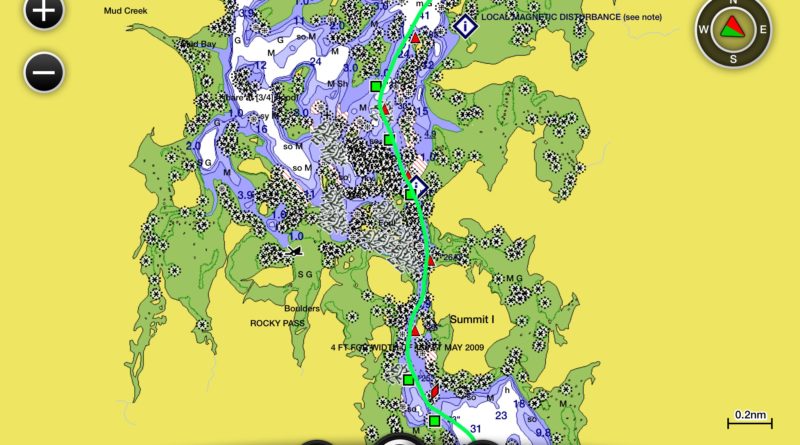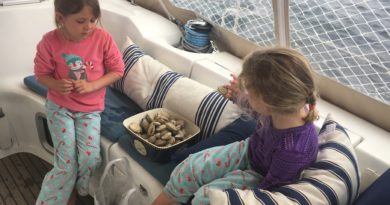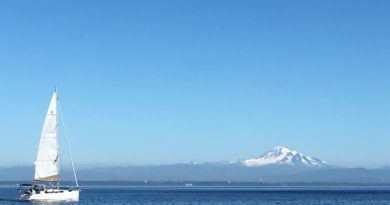Devil’s Elbow and Swift Pass – Part I
(July 22nd, 2017)
The prior evening’s briefing was different than any other we’d had. Jim gave us a series of stern warnings and instructions. It’s true that warnings and instructions about currents, uncharted rocks, and the like weren’t uncommon in our evening briefings; what was different was Jim’s stern tone. Jim is never stern.
So when he got serious on the radio, the fleet was paying attention. I pulled out my charts to see what the warnings were all about. This is what I saw:

And this:

The passage was actually worse than charted; not only did we have to avoid the rocks on the charts, but also the rocks that were not marked on the charts. In addition, swift currents and drying shelves would make the passage impossible unless we made it through Devil’s Elbow at slack high tide.
To navigate this passage, Jim laid down strict instructions. First, all boats were to rendezvous outside the passage at exactly 11AM. If anyone was late, we couldn’t make it through. Next, Jim, in Ruby Slippers, was to lead the caravan. Due to thick kelp, boats with folding props would go next; that way, if the kelp fouled their prop and prevented it from unfolding, Jim and Bill (a Marine Servicenter mechanic) would be close by to help get the disabled boat moving again. Sailboats were to keep their jibs ready, in case props or motors failed.
Once the parade began, all boats were to keep within 50 – 100 yards of the boat in front of them; driving in one another’s wake would help to ensure that the uncharted rocks Ruby Slippers was guiding us around weren’t hit by the boats at the back of the caravan. Over the radio, Jim repeated these instructions again, to ensure everyone had them in mind. With those instructions and warnings, we headed off to bed.
The next morning was drizzly, with low visibility. I woke up early, made coffee, and then pulled up the anchor and headed out for the day’s journey.
A number of boats fished on the way to the rendezvous point; we were worried about being late, so we didn’t slow down until we were much closer. With only a few miles left until the rendezvous point, and well ahead of the fleet, we passed the time with some salmon trolling. We landed one large coho, and watched another quite large one – it may have been a Chinook – jumping behind our boat as he tried to shake off our hook. Tragically, he wasn’t successful in losing the hook, but he was successful in breaking our line, with our last green hoochie and a large flasher likely to do him even more damage than if we’d landed him. A few minutes later we had a second coho on board, and it was time to rendezvous for the passage.
Mustering the fleet was like herding cats. Ruby Slippers led the line that failed to form on its own. There were radio conversations about who was following whom, and then conversations several minutes later inquiring about the multiple failures to execute. Jim was his jovial self at first on the radio: “Time to bring it on in, guys.” But as we neared the mouth of the passage, his tone changed dramatically, back to that stern tone with which we were all startled to attention: “Sail Alaska, get in line NOW.”
Eventually, the fleet was forced into a line as we made our way through the first channel, and into a small, rock-ridden bay. There we were forced to wait, motoring side-by-side against the current like an advancing army, for more than 20 minutes until slack tide hit.
At slack, Ruby Slippers led the way through Devil’s Elbow, slowly at first, but then sped up to seven knots as the fleet fell into line. Despite the fact that the front of the line was moving at a swift pace, Mobert, second-to-last, was barely making one knot. It was rush hour at Devil’s Pass, and we were in gridlock. Radio words were exchanged to encourage the boats in the middle to speed up, so that the boats in back didn’t lose steerage through the treacherous channel. We sighted a large gap between two of the Island Packets, and asked them to move along. However, no one was used to tailgating, so some boats were reluctant to get close. When Jim looked at his AIS, and saw the distance between the boats, he interjected into the conversation again with stern warnings: “Get closer. Do it. Now.” That was all the fleet needed to get over their tailgating jitters and get moving. Finally, the back of the line was moving, with good steerage. We’d made it through Devil’s Elbow.
Despite the name, Devil’s Elbow was the easiest part of the passage. As we proceeded into Swift Pass, the bottom swallowed up, and we found ourselves motoring through solid curtains of kelp. The motoring was uncomfortable, as we sat and listened to our prop grinding and shredding. Slowly, the rudder became less responsive and more difficult to move as it became fouled with flora.
We were only halfway through when the first call came on the radio: “Ruby Slippers, Ruby Slippers, Ruby Slippers, this is Zephyr.”
“Go ahead, Zephyr.”
“Hey Jim, we’ve got steam coming out our exhaust. Our engine temp is okay, but just wanted to let you know.”
“Does the exhaust sound hollow?”
“Actually, yeah, I guess it does.”
“Okay, you may have clogged your sea strainer with that kelp, so keep an eye on your engine temp, and get that sail ready.”
After a few seconds’ pause, Zephyr was back on the radio: “Yeah, Jim, our engine temp is starting to go up now.”
With a tone of measured urgency, Jim replied: “Throttle down, and get that sail out. Couldn’t’ve happened at a worse time, there’s nowhere to pull over to clean that sea strainer. Gotta keep moving.”
Ahead of us, Zephyr’s jib reluctantly unfurled, and failed to fill. Zephyr struggled to maintain two knots with her limp sail and disabled engine. Behind Zephyr, the rest of the fleet started to slow.
Back to his jovial self, Jim radioed Zephyr: “The wind just isn’t cooperating, is it?”
Zephyr responded, tensely: “No, but if we keep our RPMs low, the engine seems to do okay.”
“Okay, keep an eye on that temperature gauge, and also watch for black smoke out that exhaust. Make sure water keeps coming out.”
“Okay – we will.”
“You’re in the most narrow part of the channel now; another mile or so and the channel will open up enough to let the other boats pass you.”
Then a new voice joined the conversation: “Ruby Slippers, this is Breakaway.”
“Go ahead, Breakaway.”
“We’ll get a line ready to tow Zephyr if needed. We’re right behind them.”
“Okay, let’s wait and see how they do here.”
With one of the lead boats disabled ahead, the fleet’s pace had slowed to a crawl – less than an idle – in the narrowest, shallowest, and kelpiest part of the 10-mile-long channel. The boats behind Zephyr struggled to maintain steerage, while Zephyr struggled to maintain any speed at all. Then Zephyr came back on the radio:
“Ruby Slippers, this is Zephyr. We checked the sea strainer, and it appears to be clear.”
“Okay, then the kelp has probably fouled your prop.”
There was a pause on the radio. I looked out at the rocky shoals on either side of us that felt close enough to reach out and touch. I surveyed the kelp, so thick the channel appeared to be devoid of water. We still had some steerage, but wouldn’t for much longer if we couldn’t pick up some speed. Fifty feet in front of us, Foxy was nearly stopped.
“Ruby Slippers, this is Breakaway. Our engine temp is going up.”
“Breakaway, put it in reverse, see if you can clear some of that stuff.”
“We’ve visually inspected our sea strainer, and we can see kelp in it.”
“Okay.” No further response from Jim.





What a cliffhanger!!!! We need the next episode!